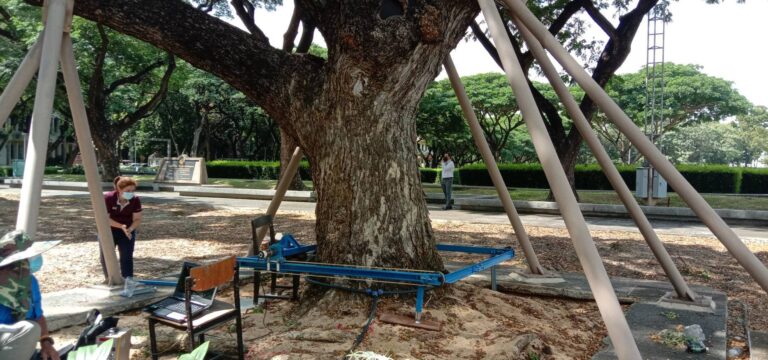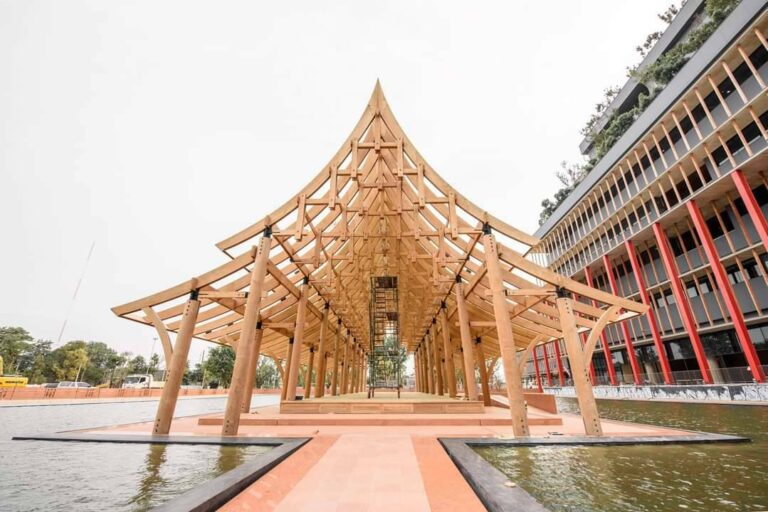
Chula’s Faculty of Engineering Pioneers the Use of Gamma Rays to Inspect Large Trees
Lecturers of the Faculty of Nuclear Technology at the Faculty of Engineering, Chulalongkorn University have developed a special device for scanning trees to determine trunk density and hollowness to prevent accidents from fallen trees and also as a way to conserve large trees in urban areas.
Large trees standing tall for years with branches spread out providing shade might look healthy and strong, yet one cannot tell whether internally the trunks might already be hollow. This can cause accidents of trees falling and injuring passersby, even causing death such as what happened five years ago when a Royal Poinciana (Flame Tree) on the Chula campus fell.
That fatal accident is what inspired Associate Professor Nares Chankow and Dr. Manusavee Lohvithee, lecturers of Chula’s Department of Nuclear Technology, Faculty of Engineering, to develop a device for scanning trees using gamma rays to determine the health of the trees via the density of the trunks making it the first and only such endeavor here in Thailand.
According to Assoc. Prof. Nares, “Gamma rays can penetrate the trunks of trees comparable to the x-ray of our body in the hospital. The procedure will help determine the tree’s health —whether its internals is healthy, have become hollow because of decay, or have been eaten up by termites and white ants. Other types of rays can also perform the task but x-rays would require the use of a generator which would require electrical currents and hence not very convenient to use.”
The use of gamma rays for healthy trees and people’s safety
Assoc. Prof. Nares further explained that the gamma-ray scanner for trees has been specially designed to provide accurate and rapid results without destroying the trees. The device comprises a gamma-ray measurement nozzle that is 3-4 times faster than average. It is connected to a computerized system that propels the belt which is controlled by remote control and installed on a hydraulic forklift.
“The gamma-ray scanning device has a nozzle that is 3-4 times faster which makes the concentration of the ray relatively lower and is thus not dangerous to the person using it. It takes only 10 minutes to examine the health of one position of the tree and if needed, scanning can be done from multiple angles or repeatedly for greater precision in each examination.”
To examine a tree, the device should be used on a flat surface with spacious surroundings which will allow easy access for the forklift or hydraulic vehicle to the tree. If the trunk is shown to be hollow, then a tree support device is installed for extra support, or cement is injected into the hollow part.
Scanning trees for the benefit of Chula and society
Since 2019, the Department of Nuclear Technology, Faculty of Engineering, Chulalongkorn University has employed the gamma-ray tree scanner as part of the Chula Big Tree project by starting with the five Chamchuri (Rain Trees) planted by H. M. King Bhumibol over 60 years ago. Unfortunately, the fifth of those trees had fallen because of a rain storm before the examination project had begun. Two of the trees were found to be seriously hollow but the University had seen to it that all four trees standing were propped up by steel rods.
Such tasks have continued until today. Aside from the four rain trees next to Maha Chulalongkorn Building, other old trees at the Faculty of Engineering and other Faculties on campus have been scanned for the safety of all Chula students and staff.
The Department of Nuclear Technology has also received requests regularly from other agencies outside Chula to provide this scanning service. Recently, three rain trees with trunks 80-95 centimeters in width along the canal at Soi Somkid between Central Embassy and Central Chidlom shopping malls were scanned. The area is set for landscape development with a pedestrian bridge added leading to Khlong Saen Saeb. Due to some limitations, since the space is quite narrow, the scanning device needed to be redesigned with a reduced size and weight. The production of this modified version took a mere 5 days and the results of the scanning showed huge hollow spaces in all three trees.
“The Department of Nuclear Technology has also used low power gamma scanning equipment to examine cracks and determine the strength of as many as 140 teak wood poles selected to be used in the construction of Thailand’s new parliament building. The project comes under the supervision of Assistant Professor Chadet Yenchai. We anticipate that in the future this equipment can be further developed making it easier to use with an automatic system that enables us to see perpendicular images inside the trees. This will also rely on the budget that can be allocated for this project.” Assoc. Prof. Nares added.
For those interested in tree scanning with gamma rays, kindly contact the Department of Nuclear Technology, Faculty of Engineering, Chulalongkorn University at Tel. +66-2218-6781
Email: [email protected] Facebook: https://www.facebook.com/NuclearChulaEngineering/ .
Source: Chulalongkorn University Communication Center
